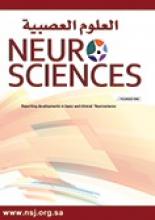Abstract
OBJECTIVE: We dedicated our work to study the socio-demographic aspect of obsessive compulsive disorder (OCD) patients seeking psychiatric treatment in the outpatient clinic of Hamad General Hospital for a duration of approximately 5 years of continuous follow-up.
METHODS: Out of 8878 individual patients who attended the psychiatric outpatient clinic of Hamad General Hospital in Qatar, during the period from August 1996 to December 2001, we reviewed a total number of 348 patients with the diagnosis of OCD (according to International Classification of Diseases-10 diagnostic criteria). We divided them according to their age, sex, nationality, duration of illness, occupation and marital status. Each patient was interviewed using a structured interview technique and evaluated by a psychiatrist in one session at the psychiatric outpatient clinic.
RESULTS: We found that the disorder is more prevalent among non-Qatari people (52%) (Arabs 36.2%, non-Arabs 15.8%) than Qatari people (48%); more common at the age groups of 31-45 years (44.8%); more frequent in the category that visited the outpatient clinic for a period of 1-4 years (60%). We found that the married females (34.5%) are affected more than the married male patients (24.7%). It was also found that in the diagnosis of OCD predominantly obsessional thoughts were 54.9%; more frequent in the sample than the other diagnosis.
CONCLUSION: In the State of Qatar, where expatriates usually outnumber Qatari patients, we discovered that non-Qatari patients are affected more with OCD than the natives. Sex, marital status and occupation also proved to be important factors. From our study, in the female married group, being a housewife seems to pose a greater risk in developing OCD. Predominantly obsessional thought was the most common sub-type of OCD affecting the patients in Qatar.
- Copyright: © Neurosciences
Neurosciences is an Open Access journal and articles published are distributed under the terms of the Creative Commons Attribution-NonCommercial License (CC BY-NC). Readers may copy, distribute, and display the work for non-commercial purposes with the proper citation of the original work.






